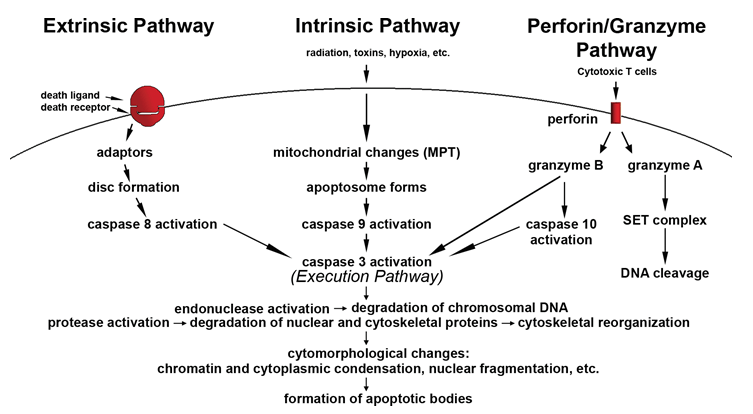With professional scientific team and advanced technique platform, Creative Bioarray can provide high-quality cell apoptosis assays to accelerate our customer's research and drug development project.
Introduction of Cell Apoptosis
Cell apoptosis, also known as programmed cell death, refers to the spontaneous and highly regulated cell death induced by the cell response to irreparable damage. Apoptosis is an active process, which is different from passive necrosis. Cell apoptosis can be initiated through the intrinsic pathway or the extrinsic pathway. The initiation is tightly regulated by activation mechanisms. Cell apoptosis involves the activation, expression and regulation of a series of genes. It is generally characterized by several morphological characteristics, including membrane blebbing, cell shrinkage, nuclear fragmentation, chromatin condensation, chromosomal DNA fragmentation, and the formation of apoptotic bodies.
 Figure 1. Schematic representation of apoptotic events. (Elmore S, 2007)
Figure 1. Schematic representation of apoptotic events. (Elmore S, 2007)
Cell apoptosis has important biological significance. It plays a critical role in embryonic development and morphogenesis, organ development, tissue remodeling, defense and immune responses, and the maintenance of homeostasis. Defective apoptosis is related to the pathogenesis of multiple diseases. Excess apoptosis can lead to hematologic and neurodegenerative diseases. On the other hand, insufficient apoptosis can result in autoimmune diseases, cancer, inflammatory disease, etc.
The study of apoptosis pathways and mechanisms is of great significance for fundamental research and drug development. An increasing number of treatments are designed to target specific signaling components of apoptosis pathways or alter the apoptotic threshold.
 Figure 2. Apoptotic priming and cellular response to chemotherapy. (Letai, A., 2017)
Figure 2. Apoptotic priming and cellular response to chemotherapy. (Letai, A., 2017)
Cell Apoptosis Assays Available at Creative Bioarray
Apoptosis is a multistep process including different cellular events. We offer a wide selection of cell apoptosis assays for accurate assessment by measuring multiple parameters.
Annexin V Assays
Annexin V can specifically bind to the negatively charged phospholipid phosphatidylserine exposed on the membrane surface. This is a marker of early stage apoptosis. In combination with other fluorescent dyes, such as PI, early and late apoptosis events can be distinguished.
Mitochondrial Membrane Potential Assays
The decrease of mitochondrial membrane potential is a distinctive feature of early stage apoptosis. It is related to the permeabilization of the outer mitochondrial membrane.
Caspase Detection Assays
The activation of caspases plays a critical role in apoptosis pathways. Colorimetric/fluorometric substrate-based assays, detection of cleavage of fluorometric substrate, Western Blotting, flow cytometry, microscopy, and microplate spectrophotometry analysis can be used to detect caspase activities.
Cytochrome C Detection Assays
Cytochrome C is an important signal substance in apoptosis. Apoptotic signal stimulated its release from mitochondial. Protein-based analysis, such as Western Blotting and ELISA can be used to analyse the presence of cytochrom C in the cytosol.
DNA Fragmentation Assays
DNA fragmentation is a hallmark of late stage apoptosis. TUNEL assay and DNA ladder can be used to detect DNA strand breaks.
Morphological Analysis
Apoptosis is characterized by several morphological characteristics. Microscopy, such as optical microscopy, transmission electron microscopy and fluorescence microscopy, can be used to observe the morphological changes of cell membrane, chromosome and nucleus.
Creative Bioarray guarantees to provide high-quality cell apoptosis assay services with fast turnaround time and competitive price. Our scientists can customize the best solution according to you specific needs. If you need more detailed information, please feel free to contact us. We look forward to cooperating with you.
References:
- Elmore S. Apoptosis: a review of programmed cell death. Toxicologic pathology, 2007, 35(4), pp: 495-516.
- Letai, A. Apoptosis and Cancer. Annual Review of Cancer Biology, 2017, 1(1), pp: 275-294.
- Goldar S, et al. Molecular mechanisms of apoptosis and roles in cancer development and treatment. Asian Pac J Cancer Prev, 2015, 16(6), pp: 2129-2144.
- Koff J L, et al. A time to kill: targeting apoptosis in cancer. International journal of molecular sciences, 2015, 16(2), pp: 2942-2955.
For research use only. Not for any other purpose.

 Figure 1. Schematic representation of apoptotic events. (Elmore S, 2007)
Figure 1. Schematic representation of apoptotic events. (Elmore S, 2007)
 Figure 2. Apoptotic priming and cellular response to chemotherapy. (Letai, A., 2017)
Figure 2. Apoptotic priming and cellular response to chemotherapy. (Letai, A., 2017)
